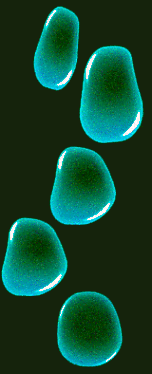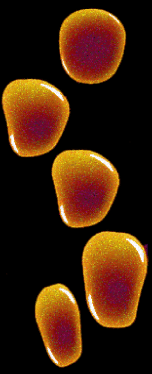


Glen Velez is one of the most influential percussionists in the world. The frame drum is his instrument of choice, and his unique touch can be heard on recordings with Paul Winter, Steve Reich, Pat Metheny, Lyle Mays, Richard Stoltzman, Peter Kater, Suzanne Vega, Patty Larkin, Joanie Madden, Noirin Ni Riain, Zakir Hussain, and Oregon. In addition to performing and recording, Glen also devotes time to teaching people how to play frame drums, both in person and through his instructional videos. He has also designed a line of drums for Remo, a leading manufacturer of drums. His most recent album, Rhythms of the Chakras, is his first truly solo effort,featuring his drumming and his voice. I recently interviewed him about this.
What inspired you to create this new album?
I was first introduced to the concept of chakras through my study of yoga and meditation many years ago. Then my girlfriend has been interested in Aura Soma therapy for number of years, which is a whole spectrum of bottles of colored oils and herbs which you can use to apply to your energy centers. I experienced this, and there were lots of gentle effects, which inspired me to think of rhythms. The color associations inspired the vowel
sounds made with the voice which gave the music a whole new character, and it seemed to be a perfect way to express the ideas of these energy systems which are essential to our bodies.
Then there were the books of Carolyn Myss who has written about chakras in a way that makes it easy to understand. Clear communication is essential in getting the ideas out to more people, and because of her, more people are familiar with this concept now than there were before. For me, this new perspective crossed over into the world of rhythm and drumming.
This album is the first one you've created specifically for therapeutic or healing purposes.
Rhythms of the Chakras, can be used simply to enjoy listening to it the same way as you would any other album, or for healing, and also for playing along with it to practice your drumming and toning.
 What makes vowel sounds so valuable in this process?
What makes vowel sounds so valuable in this process?
When you slow down from one sound to another, overtones emerge. People have been aware of this for a long time. Buddhists, Christians, Hindus, and many others created altered states in their religious ceremonies by elongating the vowels. This changes the way a person listens. When you are doing it, your breathing stimulates an intense change of consciousness.
How has this album been received so far?
I've had more feedback on this than any other recording I've done. Maybe it's because a lot more people are interested in healing and it's exciting for Westerners to explore these ideas this way. I paid attention to weaving rhythms and combining different speeds the same as I have on previous albums. And maybe it's because this is my first truly solo recording. The feedback I am getting is that it's a lot of fun to play along with this one.
Rhythms of the Chakras overlaps with your teaching then.
Yes. When you teach you look at ways to create situations to see things in new ways. When you develop new material, you discover ways to put things together. A lot of what I do is intuitive and not thought out before I do it. Teaching slows this process down. I'm asked how something works or how it got that way, so I have to stop and think in order to explain it. Sometimes I just know what sounds better, what feels better. It's like asking someone why they like chocolate. It's not easy to answer a question like that. If you started to teach a course in ice cream, you'd find out about people's tastes and preferences. Our choices in music are intuitive. They involve our emotions, the way we were brought up, and all kinds of other factors that put together form our tastes.
 When I teach, I prefer to use walking and speaking to learn about rhythm. This allows us to put everything together to do complicated things. Our sense of pulsation is based in our ability to move through space. Vowels are key to allowing language to evolve. Pulsing and vibration are the basic material of life. It's a simple way of looking at it, but it's a way of looking at life. That's what makes drumming a transformative experience. These pulsations and rhythms let us know what it means to be swimming in life.
When I teach, I prefer to use walking and speaking to learn about rhythm. This allows us to put everything together to do complicated things. Our sense of pulsation is based in our ability to move through space. Vowels are key to allowing language to evolve. Pulsing and vibration are the basic material of life. It's a simple way of looking at it, but it's a way of looking at life. That's what makes drumming a transformative experience. These pulsations and rhythms let us know what it means to be swimming in life.
Some people think there is one specific note on the scale assigned to each chakra, and others simply think of it as an ascending sequence.
I like concept that in one sound all the other sounds are contained, that overtones from vowels will bring out different notes in that one tone. Vowel sounds are produced by the resonant chambers in the head. These sounds unify everything. Even though chakras are separate, they are unified in each body. So by concentrating on each one, one by one we strengthen the
whole body. Unified but separate is an example of metaphysical idea that is simple yet profound. All notes are separate, yet they are all part of the same whole sound.
 There seems to be an important connection between sound and color.
There seems to be an important connection between sound and color.
There is a way of learning perfect pitch, that involves these two. We have a natural thing that starts happening with pitches we hear, and we picture color to identify different pitches. There are many uses in the crossover between the two systems of vibration. I hear musicians say that certain pitches stimulate them to think in terms of color. Drumming affects people so deeply because you are focusing in on this basic area of life, the power of vibrational rates, and what it means to be alive. It offers us another view of reality.
What's your favorite album of all you've recorded?
There are things I like about every project. Once I m done with it, I rarely go back and listen to my albums. Maybe some day when I'm 90 and too old to hold a drum up I'll sit around and listen to the music I used to play.
